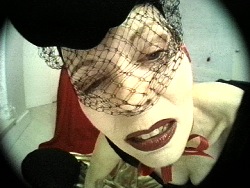Ursula Hodel
Biography
With irony, humor and an outrageous sense of style, Ursula Hodel's performance gestures conflate desire, consumerism, vanity, and the female body, and put a new spin on the idea of video as mirror. Using herself as the main subject of her video work, Hodel explores notions of beauty, hedonism, narcissism and self-obsession.
Hodel began producing video in 1995, after pursuing eclectic fields and media, including ceramics, psychology and fencing. Her body of video work is divided into two main series. The Past Lives series includes works based on texts written by the artist during states of trance. Here she combines narrative with poetic images, locating her stories in a grey area suspended between the real and the fictional. In the Performance Tapes series, Hodel enacts intimate acts of indulgence and self-gratification, such as eating, masturbating, or changing clothes. While the first series of works presents the artist as silent and reflective, with only a voice-over unfolding the narrative, the Performance Tapes are more dynamic, with the artist engaged in ritualized and compulsive activities. In many of her videos, Hodel appears wearing glamorous couture outfits and make-up, offering an intriguing contrast between an image of alluring diva and the ageing female body.
Most of Hodel's videos are set in private spaces, including her own apartment or hotel rooms. She uses the video camera as mirror for intense and dramatic performances in which she focuses on the objects, images, rituals, and fantasies through which her desire takes form. Her works manifest a dichotomy between a narcissistic desire, in which the artist seeks a reflection of herself, and a desire to translate her passions into activities. Hodel's videos also reveal a tension between performing in private, exclusively for herself, and performing in front of a camera, in which she presents herself to an audience. During the recording process, Hodel works completely alone before the camera, while the image and sound post-production that defines many of her pieces is highly collaborative.
With their elements of luxury, glamour and fetishization of everyday objects, as well as their focus on the psychological relation between desire and reality, Hodel's works present a startling and ambiguous glimpse into contemporary notions of consumerism, narcissism, and self-image.
Ursula Hodel was born in Solothurn, Switzerland. She attended the Royal Academy of Fine Art in Brighton, England. Her work has been shown both nationally and internationally, at venues such as the Centre d'Art Contemporain de Rueil, Malmaison, France; Museum Artes, Quito, Ecuador; The Euro Underground Film Festival, Paris; Palm Beach Institute of Contemporary Art, Florida; Artists Space, New York; Swiss Institute, New York; Solomon R. Guggenheim Museum, New York; and The Museum of Modern Art, New York.
Hodel lives in New York City.
